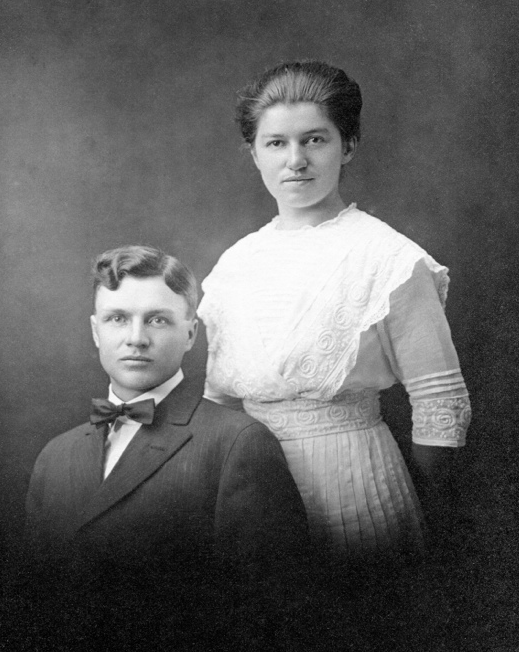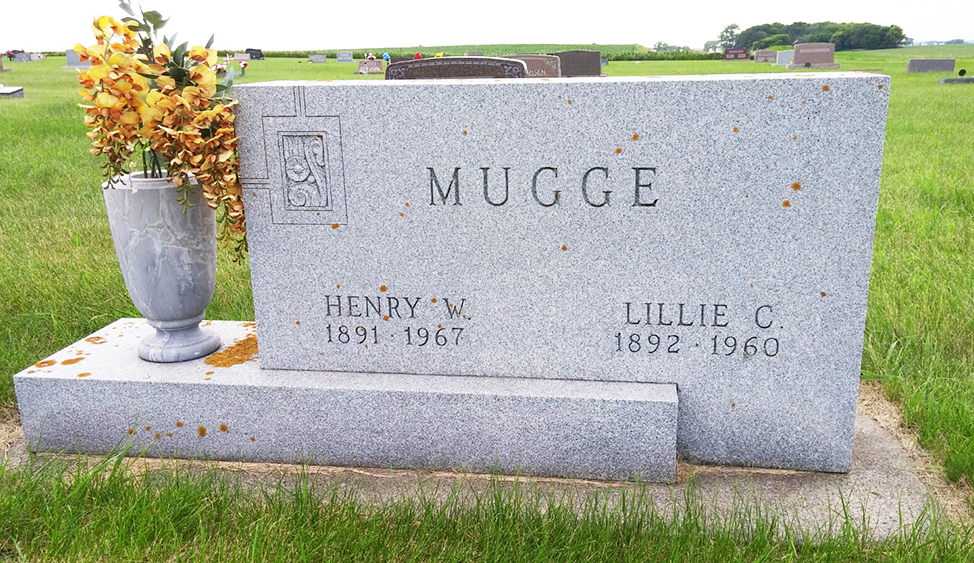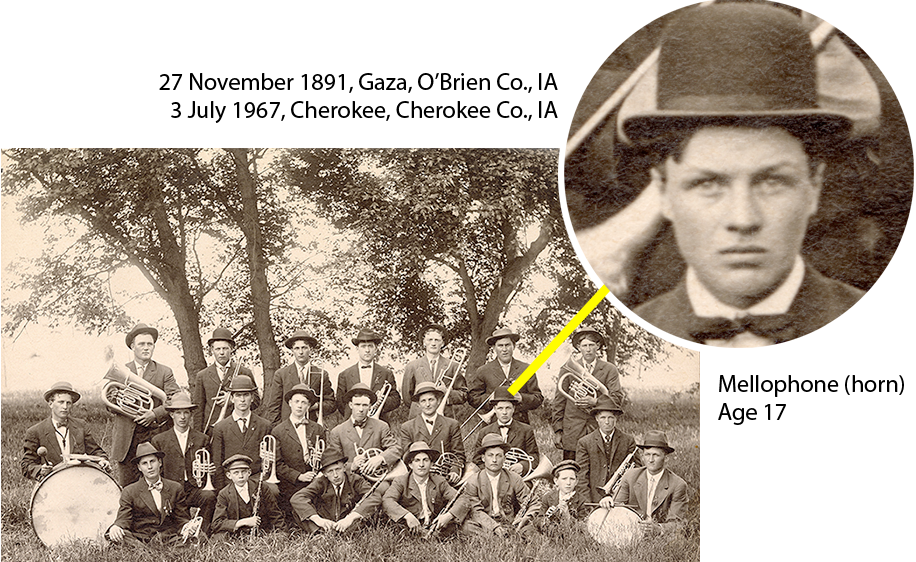
Henry William Mugge(1) was the second child and oldest son within the family of 10 children of Johann Hermann Mugge (1865-1931) and Bertha Henrietta Dora Steffens (1868-1946). The other siblings in this large family were Clara Margaretta Sophie (1890-1985), Harry Dietrich (1893-1956), Elmer Henry (1895-1968), Ernest Dietrick (1897-1974), Arthur August (1899-1981), Raymond John (1901-1971), Nora Sophia Emma (1903-1996), Lester Otto (1906-1967), and Alta Rebecca (1907-1960).
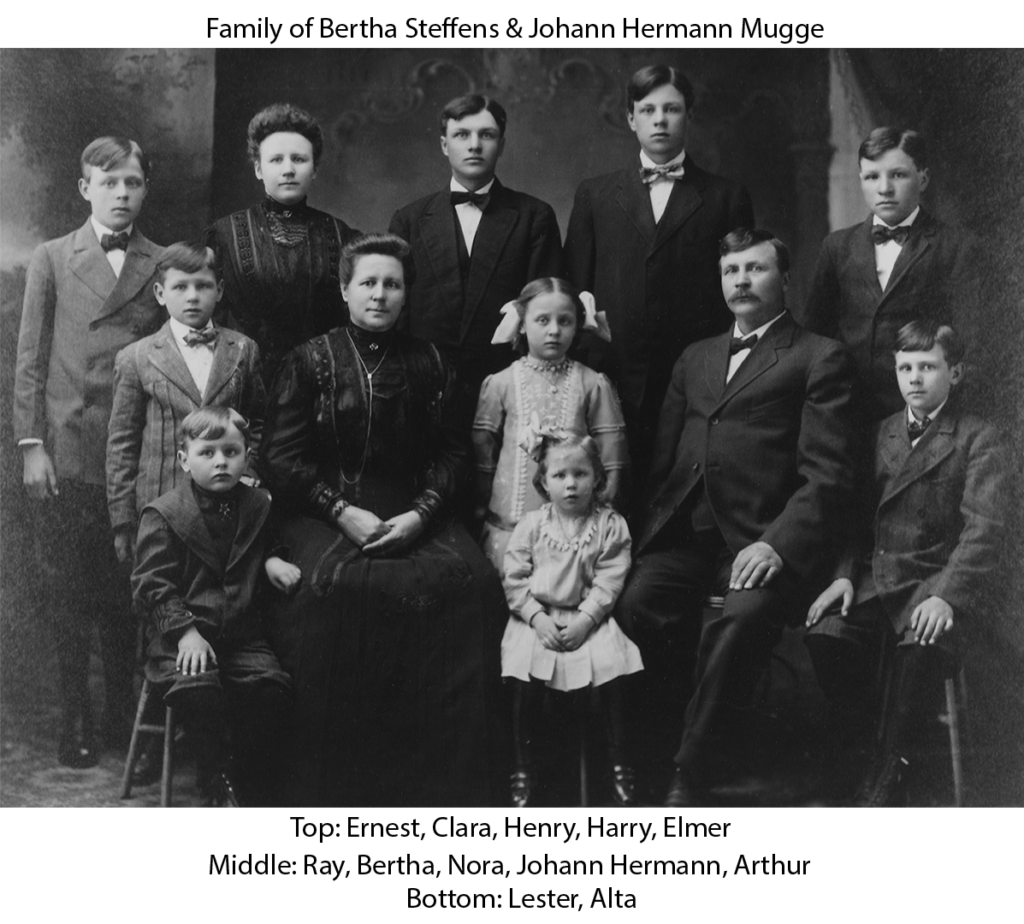
A photograph of the family most likely dates from late 1909 or early 1910, contemporaneous with the Calumet German Band photo.
Most Calumet German Band member families left from far northern Germany in the late 19th century; Johann and Bertha came not from Schleswig-Holstein itself but from Lower Saxony, just to the south of Schleswig-Holstein. Johann had immigrated in 1883, and Bertha in 1870 — earlier than for some other band members’ families. Both families settled originally in Wisconsin, but Johann relocated in 1888 to Liberty Township in O’Brien County, Iowa, and Johann and Bertha were married in the town of Sutherland in 1889. Their farm was located three miles to the west of Calumet.
Three years after the Calumet German Band photo, on 6 September 1912 in the town of Primghar (seat of O’Brien County), Henry married Lillian “Lillie” Cecelia Kundel (1892-1960).
At the time of the marriage, Lillie lived just two miles north of Johann and Bertha Mugge’s farm, with her parents John Claus Kundel (1859-1934) and Dorothea “Dora” Rohwer (1862-1932) as well as her grandmother Catharina “Trina” Möller Kündel (1828-1912) and several younger siblings who were still in the household.
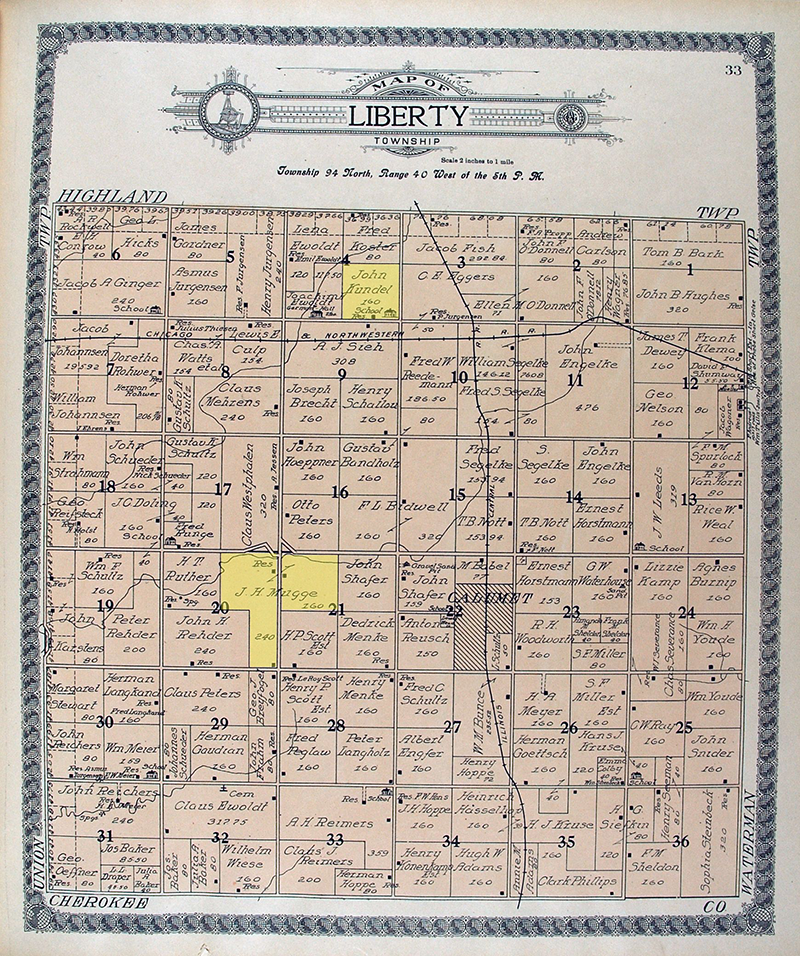
Like other band members’ families, the Kundels (Kündels) had come from Schleswig-Holstein and followed a typical migration pattern, landing first in Scott County, Iowa, then moving to the equally important German immigrant area of Tama County before moving on to points west and northwest. John Claus Kundel had immigrated in 1870, and Dora Rohwer even earlier in 1865. Their marriage was in 1882 in Davenport (Scott County).
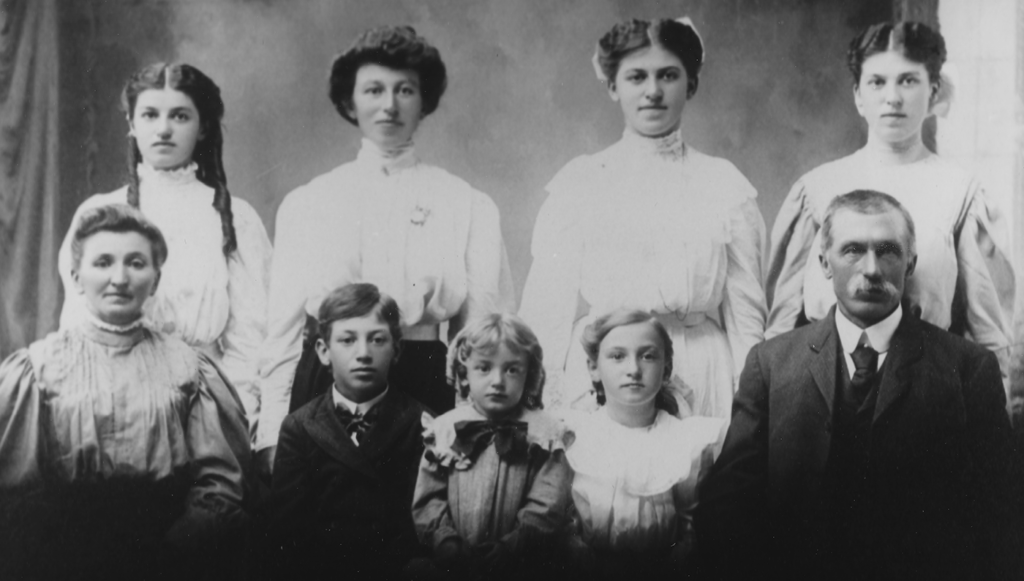
As with the Mugge family, the Kundel family was large, with seven surviving children, the first four of whom were born in Tama County, and the last three in O’Brien County. In addition to Lillie, the Kundel children were Alma Catherine (1884-1963), Elizabeth “Lizzie” Emma (1888-1969), Lulu “Lou” Frances (1890-1965), John Charles (1896-1943), Olive Dorothea (1900-1978), and Roy Harold (1903-1970). Another son, Charles (1894-1895), had died at eight months of age.
Following in the farming tradition of their parents — and like several other Calumet German Band members — Henry and Lillie established themselves as farmers and were closely connected with the German Evangelical Lutheran Church in Calumet.(2)
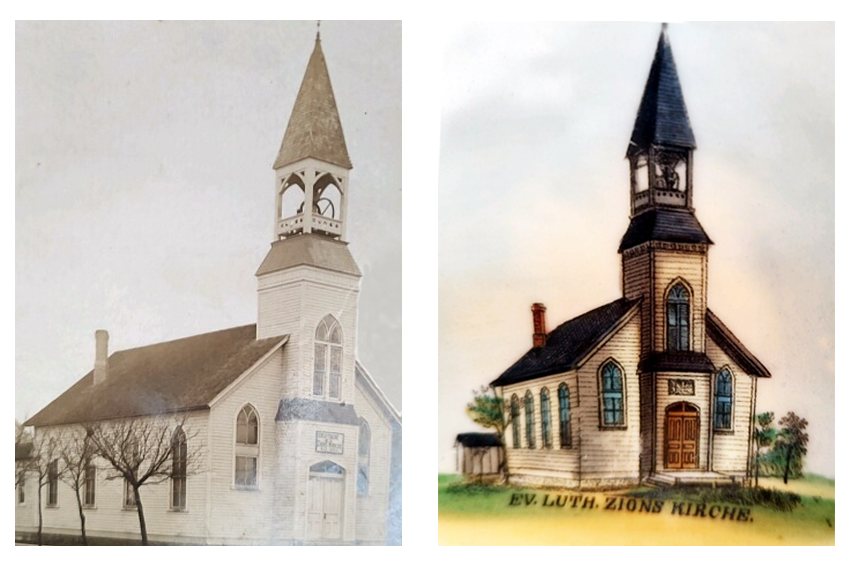
After their marriage, Henry and Lillie relocated briefly to Canova, Miner County, South Dakota, probably motivated by the move of Lillie’s older sister, Lizzie, and her spouse Bernhart A. “Ben” Schierholz (1882-1962), as well as several other Schierholz family members. There the first three of Henry and Lillie’s four children were born. But an unusually rainy season in the region sometime between 1916 and 1920 caused widespread crop failures, and the family moved back to Iowa. As they resettled in the Calumet area, Henry and Lillie farmed just a couple of miles from where they each had grown up. Additionally, as shown on a 1940 plat map, the farm of Henry and Lillie Mugge was directly across the road from one parcel of land owned and farmed by Henry’s bandmate Albert Mehrens (1891-1957).
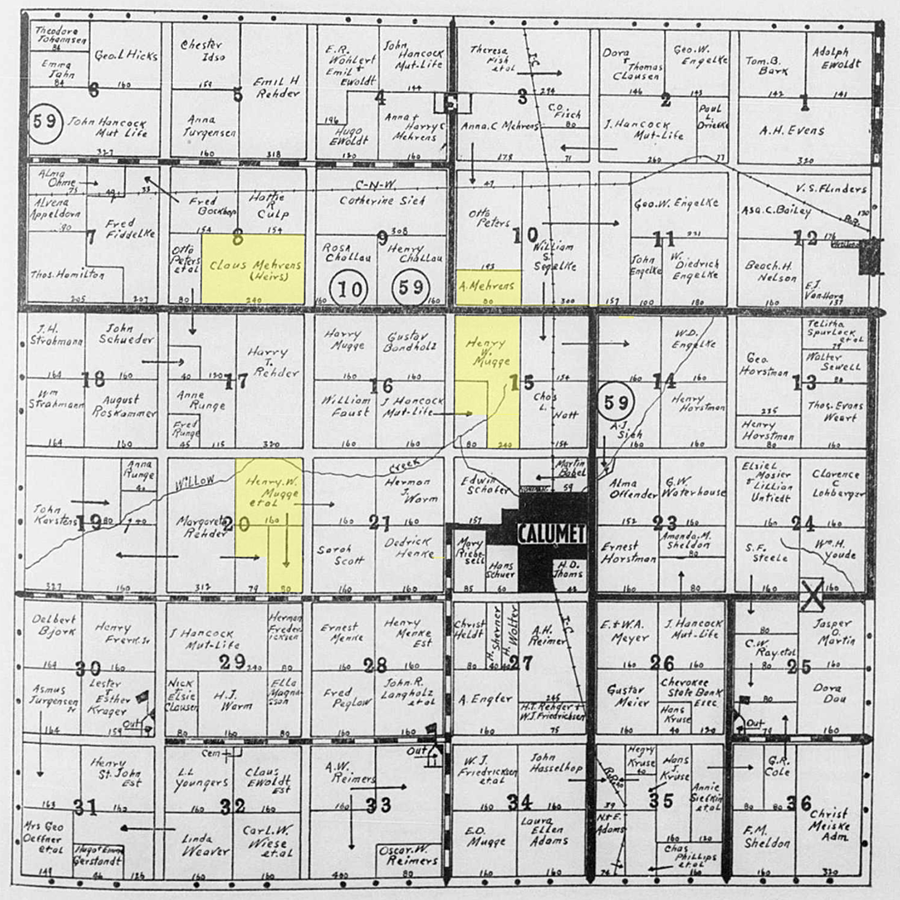
Henry and Lillie continued to farm there until retirement. In 1948, they purchased a lot in the town of Sutherland and built a house there for their remaining years. Lillie died on 26 July 1960 at age 68, and Henry remarried on 6 January 1962 to Verna Clare Stoaks (1889-1976), also a widow. Verna Stoaks’s first husband, Albert Henry Schultz (1882-1959), was a well-known Sutherland businessperson, town clerk, and postmaster who had himself lost his first wife, Alta May Briggs (1886-1921), at a young age.
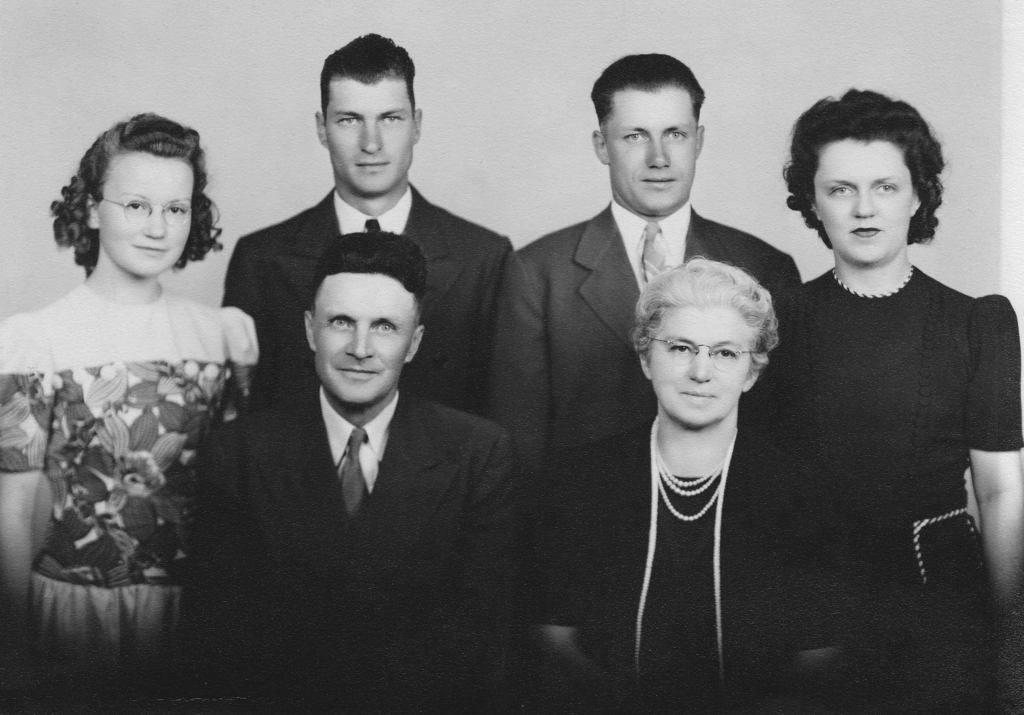
In the long marriage of Henry Mugge and Lillie Kundel Mugge, the couple had four children: Lloyd Herman Mugge (1913-1990), Lyle John Mugge (1915-2000), Dorothy June Frances Mugge (1916-2001), and Bertha “Birdie” Lou Nora Mugge (1929-2014):
• Lloyd H. Mugge married Clara Helen Mews (1915-2006) in 1936, and the couple farmed in O’Brien County, then Clay County, before moving to northern Minnesota in the 1940s, where Lloyd worked in the iron mining industry. They had four children, all boys, who remained in the northern Minnesota area with their families: Jimmie Alan Herman Mugge (1937-1970), Gale William Mugge (1939-2017), Lynn Henry Mugge (1941-2017), and Alan Irvin Mugge (1944-2021).
• Dorothy J. F. Mugge became an educator, receiving her PhD from Teachers College of Columbia University. Early in her career she taught abroad in U.S.-based international schools, and she later held university faculty positions in early childhood education, at Shippensburg University of Pennsylvania and then at California State University-Long Beach. She married late in life, to Carl Ragnar Johnson (1904-1987), a widower, and the couple spent their remaining years in Minneapolis.
• Lyle J. Mugge continued in the family’s farming tradition, which was interrupted by service in the Army in World War II and after which he married Mildred Eva Yoakam (1915-2010) in 1946. The family farmed in Liberty Township near the farms of his father Henry Mugge and his grandfather Johann H. Mugge. There they raised three sons and one daughter: Wayne Douglas Mugge (b. 1950), Paul Henry Mugge (b. 1951), John Howard Mugge (b. 1954) (the writer of this narrative), and Judith Ann Mugge (1957-2024).
• Bertha Lou (known as “Birdie Lou”) completed graduate work at Iowa State University in chemistry and experimental foods. She married Hugh Arthur Poston (1929-2017) in 1954, and she worked as a home economics teacher in Cortland County of upstate New York; Hugh Poston had received his PhD in animal physiology, and he worked as a research physiologist with the U.S. Fish and Wildlife Service. The couple lost two children as infants (Rebecca Lou Poston, 1957-1957, and Scott Hugh Poston, 1959-1959) but then adopted three children: Mark Henry Poston (b. 1960), Martha Jo Poston (b. 1962), and Phyllis Cecelia Poston (b. 1964).
In his later years, Henry W. Mugge continued to be involved in the farming operation of his son Lyle J. Mugge, in Section 9 of Liberty Township. At the time of this writing (2023), that farm, now converted to organic production, continues under the operation of Henry’s grandson Paul Henry Mugge (b. 1951).
Henry William Mugge and Lillie Cecelia Kundel Mugge are buried in Liberty Cemetery near Calumet.

Subscribers to Ancestry.com may wish to further explore some family connections of Henry Mugge by accessing an Ancestry profile page (within the context of a “Mugge Family Tree”).
Connection to Other Band Members
Family connections and farm-neighbor relationships within Liberty Township of O’Brien County connect Henry Mugge to half of the Calumet German Band members. The most important of these connections are detailed on individual pages for other band members, each with schematic illustrations of the relationships.
For details, visit these biosketch pages:
• Henry Andersen
• Charles Bandholz
• Newell Bidwell
• John Brumm
• William Eggers
• Henry Friedrichsen
• Henry Lorenzen
• Albert Mehrens
• John Mehrens
Footnotes
(1) As with the surnames of several other band members, there are spelling variations; the umlaut was dropped from the name Mügge upon arrival to the U.S., and the anglicized version among different wings of the family has been spelled as both Mugge and Muegge. In the wing of the family represented by Johann Hermann Mugge and children, the surname is pronounced MUGG-ee. The family name of Henry’s wife Lillie Kundel, likewise, exists in several variations: Kündel, Kundel, and Kuendel.
(2) Later known as the German Evangelical Church of Calumet. In still later name changes, the church became the Zion Evangelical and Reformed Church, and finally the Zion United Church of Christ.

